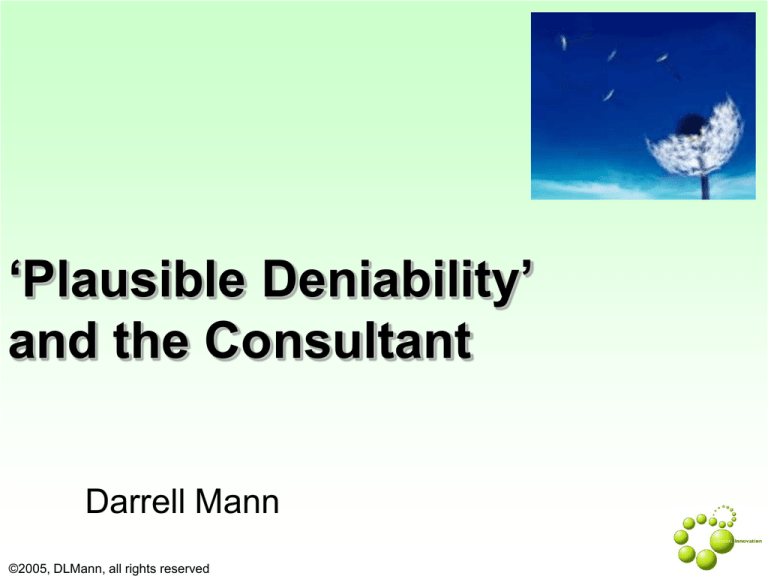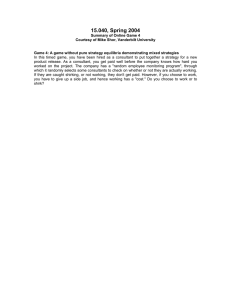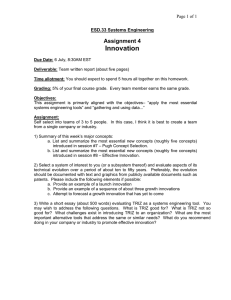
‘Plausible Deniability’
and the Consultant
Darrell Mann
©2005, DLMann, all rights reserved
‘Plausible Deniability’ and the Consultant
1) Plausible Deniability
2) TRIZ, Spiral Dynamics And The Consultancy Context
3) Clients Are Wary Of Taking On Consultants Because…
4) Perception Mapping
5) Eliminating Contradictions
6) Summary
©2005, DLMann, all rights reserved
Plausible deniability
is the reason
that clients are looking for
(either implicitly or explicitly)
to justify their decision
not to offer contracts to
external consultants.
©2005, DLMann, all rights reserved
Two Primary Human Motivators
Individual
©2005, DLMann, all rights reserved
1) The consultant approaches a prospective client with a proposal that
something should be changed
2) the client is faced with a difficult decision; pleasure-seeking thinking points
in the direction of giving the idea a try because there is an opportunity to look
like a hero to superiors. Pain-avoidance thinking on the other hand points in
the direction of not changing anything, because if something goes wrong, there
are going to be questions along the lines ‘why did you tamper with a perfectly
satisfactory system?’ Generally speaking, in most large organizations, pain
avoidance tends to dominate pleasure-seeking, and so the client is likely to
err towards the do nothing approach.
3) The do-nothing approach, however, also carries with it the potential of pain:
what if someone else (e.g. a competitor) adopts the change idea and it turns
out to be a success? In this situation, the questions coming down from above
will be things like ‘why didn’t you see it coming?’ or – absolutely catastrophic if
news gets out that you turned the idea down – ‘what on earth caused you to
reject that?’
4) In order to make sure there is a good answer to this potentially career limiting
scenario, the manager, therefore needs a plausible explanation for why not
adopting the change was the correct thing to do.
©2005, DLMann, all rights reserved
TRIZ
Teoriya Resheniya Izobreatatelskikh Zadatch
Theory of Inventive Problem Solving
©2005, DLMann, all rights reserved
The Systematic Innovation
Approach
A
Problem
Like Mine
My Specific
Problem
©2005, DLMann, all rights reserved
A
Generic
Solution
My Specific
Solution
The Ideal Creativity & Innovation Method?
Axiomatic
Design
Function
Analysis Value
Engineering
Chaos Theory
CPS
TRIZ
MA
Design for
Manf/Assy
Pugh
Theory Of
Constraints
VSM
Osborn
Oblique Strategies
ZBB
6
Kansei
DeBono
NLP
Spiral
Dynamics
Taguchi
Shainin
Pahl/Beitz
spc
WOIS
QFD
©2005, DLMann, all rights reserved
KepnerTregoe
Simplex
Buzan
Systematic Innovation Evolution
Content
AD/DFMA
Complex
Systems
Business
Function
Analysis
6Sigma
QFD
Soviet TRIZ
1946
©2005, DLMann, all rights reserved
1985
DeBono
/Buzan
2000
TOC
2003
Universal Systematic Innovation Methodology
AD
FA/VE
Shainin
TRIZ
TOC
6
DFMA
NLP
QFD
©2005, DLMann, all rights reserved
Systematic
Innovation
Spiral
Dynamics
Taguchi
DeBono
TOP 10 Teaching TRIZ Issues
– S-Curves Are Everywhere
Western Roll
Fosbury Flop
ALL
Systems Hit Limits
©2005, DLMann, all rights reserved
The Overriding Importance of Evolutionary S-Curves
Measured Parameter – Cost, Profit, ROI, Efficiency, etc
good
target
Fundamental Limit of Capability
poor Current System
©2005, DLMann, all rights reserved
Time
The Overriding Importance of Evolutionary S-Curves
Measured Parameter
target
Fundamental Limit of Capability
Two Options
1) Change the target
2) Change the System
Current System
©2005, DLMann, all rights reserved
Maslow Hierarchy of Needs
Physiological
Needs
Safety
Needs
Social
Needs
Esteem
SelfActualisation
Source: Understanding Organisations, Charles Handy, Penguin, 1976.
Self Actualisation
Social
Safety
Phys
©2005, DLMann, all rights reserved
Esteem
* Discontinuous Shifts
in consciousness/thinking
* ‘MEMEs’
* Potential for change
©2005, DLMann, all rights reserved
Level
Of
Consciousness
8. Turquoise - Holistic
7. Yellow –Holarchies
6. Green – Communitarian
5. Orange - Scientific
4. Blue - Order
3. Red - Feudal
2. Purple - Tribal
1. Beige - Survival
Time
©2005, DLMann, all rights reserved
Shifts To New Levels Occur Only When Contradictions Emerge
1. Survival
fundamental limits to individual survival ability (need for
sleep, parenthood, catching prey, etc) means there is a
benefit to becoming part of a social group
2. Tribal
when times become tough in the social group, the fittest
will survive, and so there is evolutionary pressure to
fight through the group hierarchy
3. Feudal
4. Order
5. Scientific
6. Communitarian
There are limits to how much a single dominant person
can achieve without ‘buy-in’ from others. This can only
be achieved (in the long term) by introducing ‘fair’ rules
The ordered rule-bound system does not respond well
in times when there is a need for adaptation and change.
need for innovation emerges; which prompts need for knowledge
Individual materialism eventually impacts on external factors that
prevent further growth, prompting a need to think about ‘system’
and the concept of ‘enough’
The drive for equality and ‘fairness’ eventually hits a limit of
indecision, procrastination and in-action, which then provokes
recognition of the existence of ‘natural hierarchies’
7. Holarchy
8. Holistic
Recognition that all systems hit limits applies to all systems, and
that sometimes it is necessary to completely shift to a new
(higher level) integrated alternative
etc
©2005, DLMann, all rights reserved
Interact at the same level as the
current state of the
client…
….or expect your proposal to fail
©2005, DLMann, all rights reserved
Mapping Interactions Where Positive Change Outcome
Will Occur
1
2
3
4
5
6
7
8
Thinking Level of Receiver
Thinking Level 1
Of Provider
2
3
4
5
6
: interaction where there will
be a meaningful and positive
outcome
7
8
Paper at TRIZ Kongress, June 2005
‘If TRIZ IS So Good, Why Isn’t Everyone Using It, Part 7:
Plausible Deniability & Spiral Dynamics’
©2005, DLMann, all rights reserved
Clients Are Wary
Because….
©2005, DLMann, all rights reserved
Typically Cited Reasons:a)
b)
c)
d)
e)
f)
g)
h)
i)
j)
k)
l)
m)
n)
o)
p)
q)
Perceived to be too expensive
No guarantee of success
Lack of belief that consultant can understand context
Wariness about signing ‘blank cheque’
Poor previous experiences
Wariness of employees working with consultants
‘Using your watch to tell you the time’ market perception
Disruptive to organisational processes
Might uncover something we don’t want uncovered
Might give us a message we don’t want to hear (ostrich effect)
One bill leads to the next
Overselling (senior consultant sells; junior delivers)
Significant part of cost is ‘catching up’
Lack of time to find most appropriate consultant
Lack of knowledge of actual consultant capability
Buy-in more likely if solution comes from within
Consultant will take up too much of my time
©2005, DLMann, all rights reserved
Perception
Mapping
©2005, DLMann, all rights reserved
SYSTEM OPERATOR in (Many) Business Problems
The Map Is Not The Territory….
Merely Our Perception Of It
Behaviour
“The Map”
Physical
Super-System
“The Territory”
System
Sub-System
Past
©2005, DLMann, all rights reserved
Present
Future
Perception Mapping Process
0) Formulate a question
1) List perceptions of the situation
2) Give each perception an identifier
3) For each perception, ask ‘which of the
others does this one lead to?’
4) Do any of the perceptions conflict with
one another? (Identify pair/pairs)
5) Construct the perception map
6) Focus on loops, collectors and chains
©2005, DLMann, all rights reserved
Leads To….
a)
b)
c)
d)
e)
f)
g)
h)
i)
j)
k)
l)
m)
n)
o)
p)
q)
Perceived to be too expensive
No guarantee of success
Lack of belief that consultant can understand context
Wariness about signing ‘blank cheque’
Poor previous experiences
Wariness of employees working with consultants
‘Using your watch to tell you the time’ market perception
Disruptive to organisational processes
Might uncover something we don’t want uncovered
Might give us a message we don’t want to hear (ostrich effect)
One bill leads to the next
Overselling (senior consultant sells; junior delivers)
Significant part of cost is ‘catching up’
Lack of time to find most appropriate consultant
Lack of knowledge of actual consultant capability
Buy-in more likely if solution comes from within
Consultant will take up too much of my time
©2005, DLMann, all rights reserved
d
l
f
b
g
p
a
f
f
c
d
g
a
o
q
b
h
Making Sense Of The Complexity
Clients are wary because:
- no guarantee of success
- employee wariness/buy-in
©2005, DLMann, all rights reserved
Win-Win Conflict Elimination Matrix
for Business
& Management
Darrell Mann
©2005, DLMann, all rights reserved
Someone, somewhere already solved your problem…
©2005, DLMann, all rights reserved
Putting It All Together
Summary
©2005, DLMann, all rights reserved
* People naturally veer to zones of comfort
* Often difficult to break out of this closed mindset
* Address people at their prevailing Meme-level or
expect to fail
* Everyone’s map of the world is different
(also ‘you can never step in the same river twice’)
* Guarantee of success and employee wariness as
key consultant success drivers
* Manage and use perceptions and complexity
(every complex problem has a simple, wrong answer)
©2005, DLMann, all rights reserved
Scan Family
Overall Company
(O-Scan)
Health Scan
(H-Scan)
Innovation Scan
(I-Scan)
etc
www.creax.com/cis
www.creax.com/csa
(Individual) Creativity Scan
(C-Scan)
©2005, DLMann, all rights reserved
Technology Scan
(T-Scan)
(Evolutionary Potential)
www.systematic-innovation.com
darrell.mann@systematic-innovation.com
©2005, DLMann, all rights reserved


